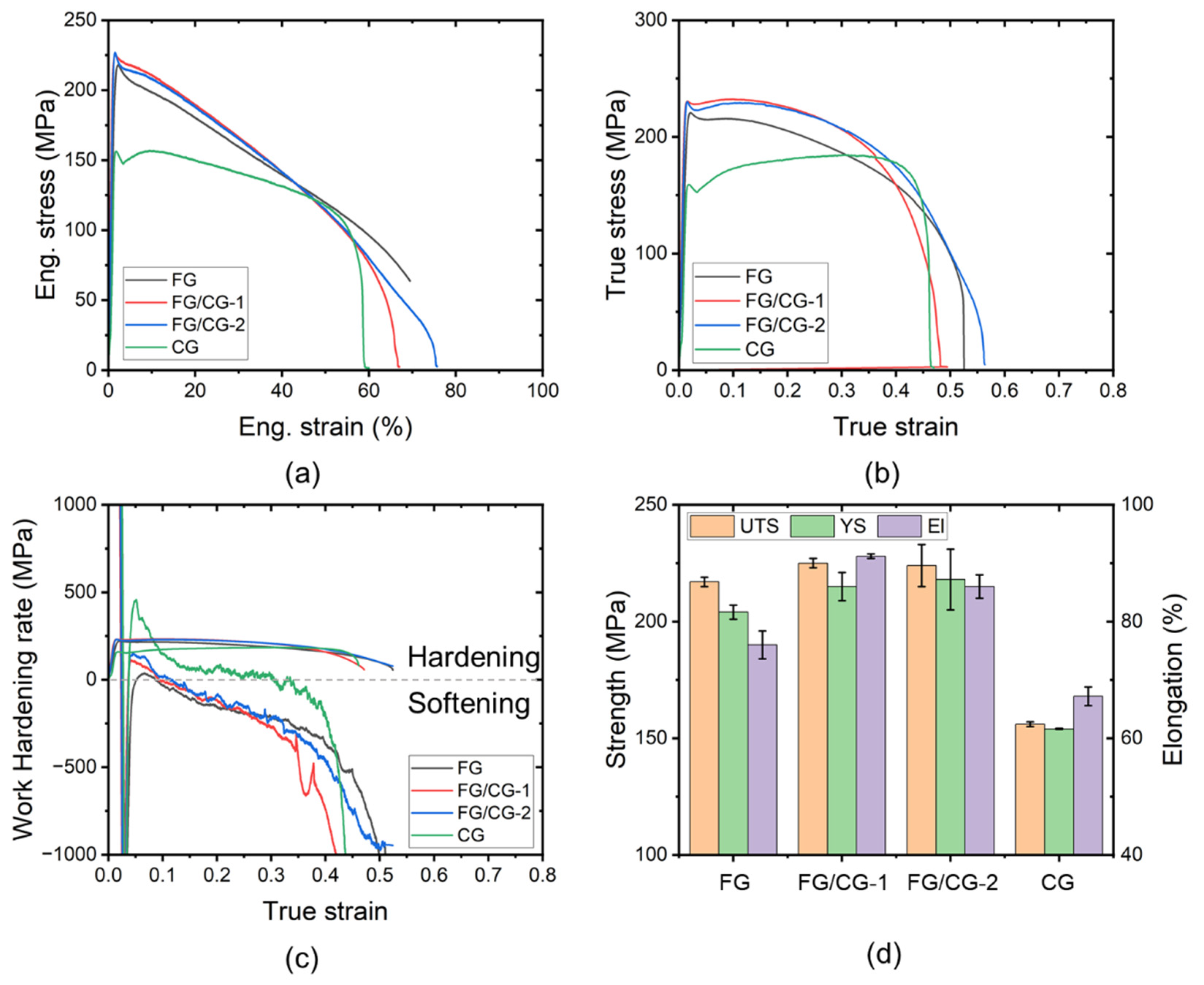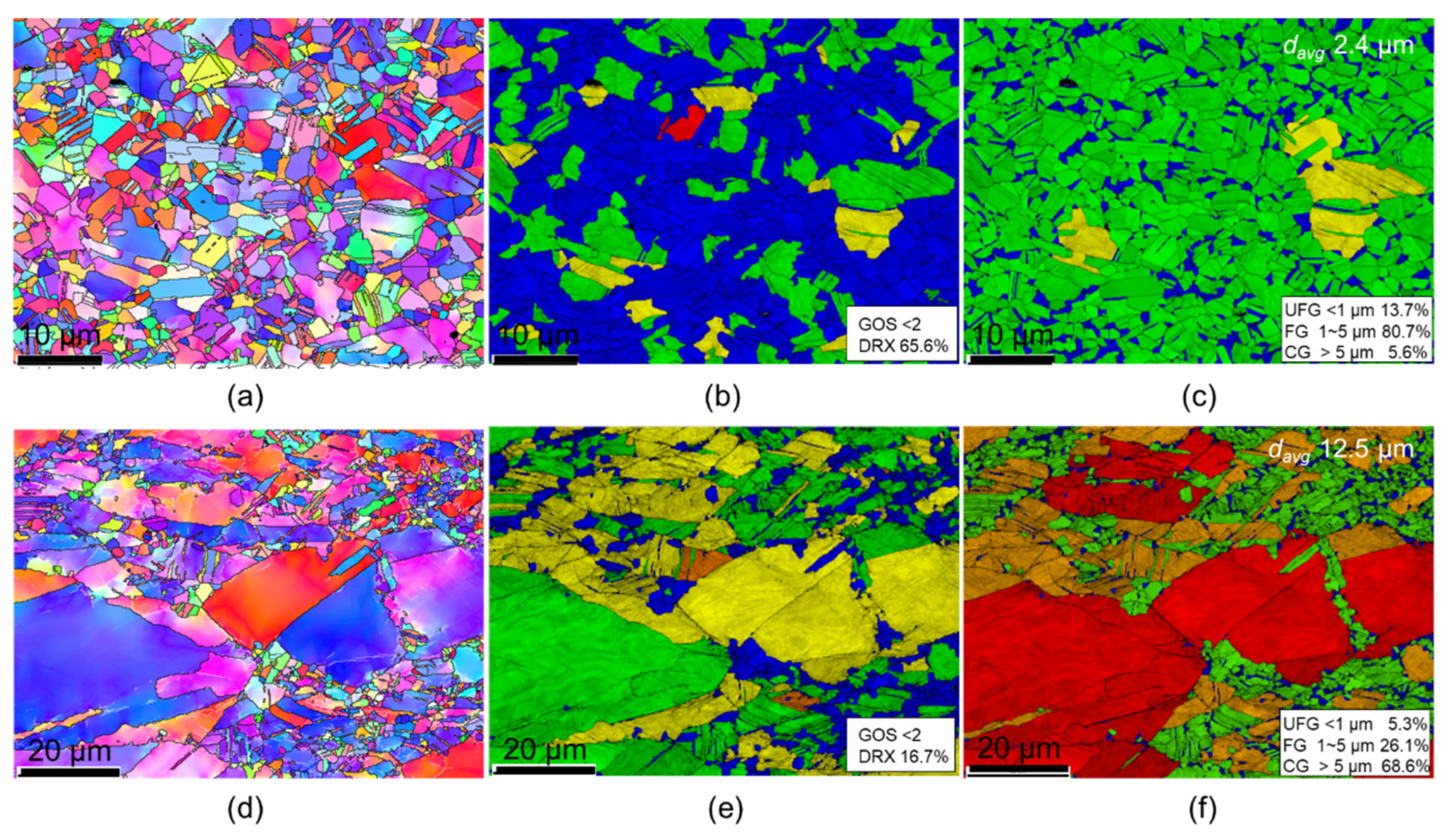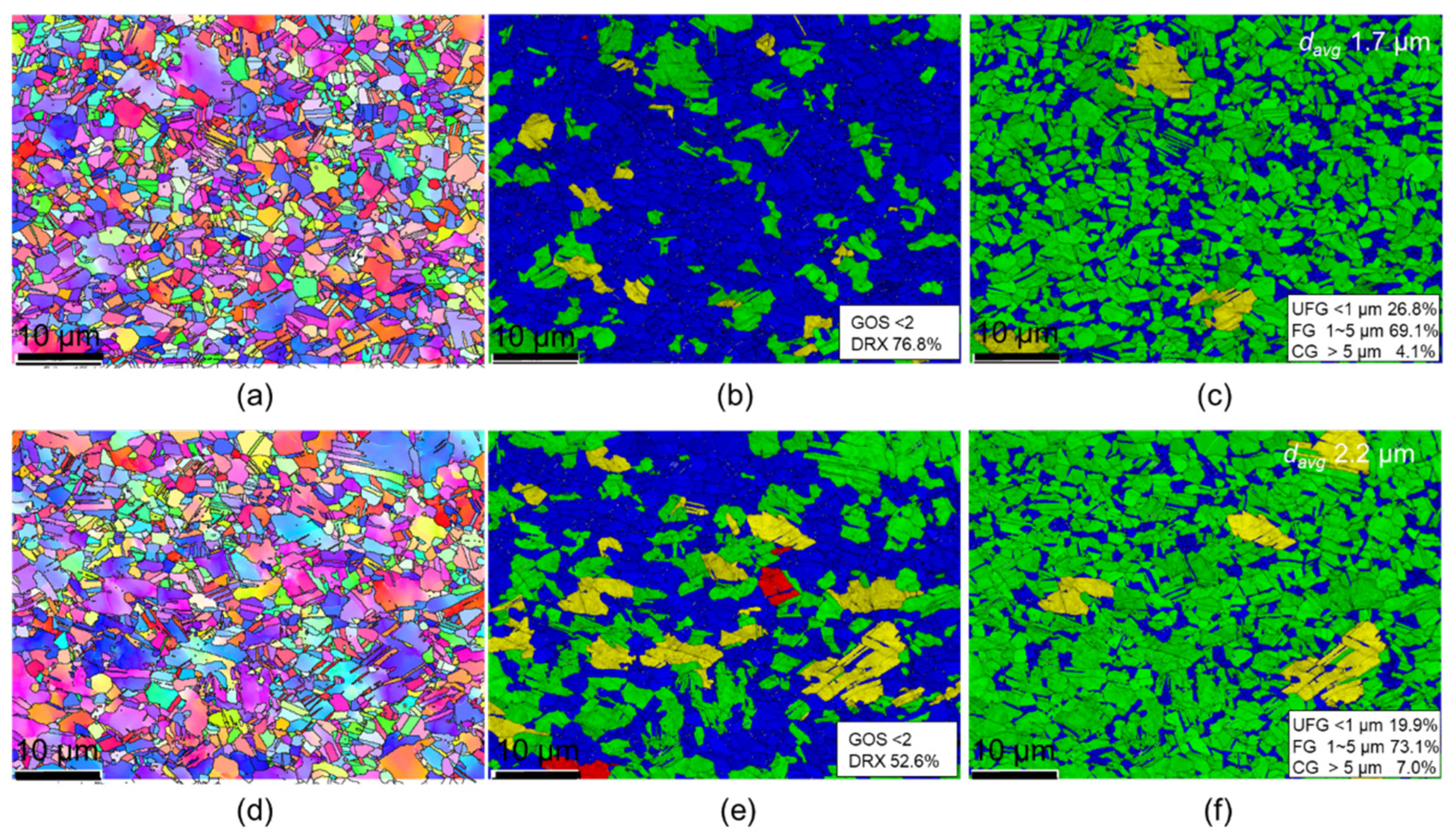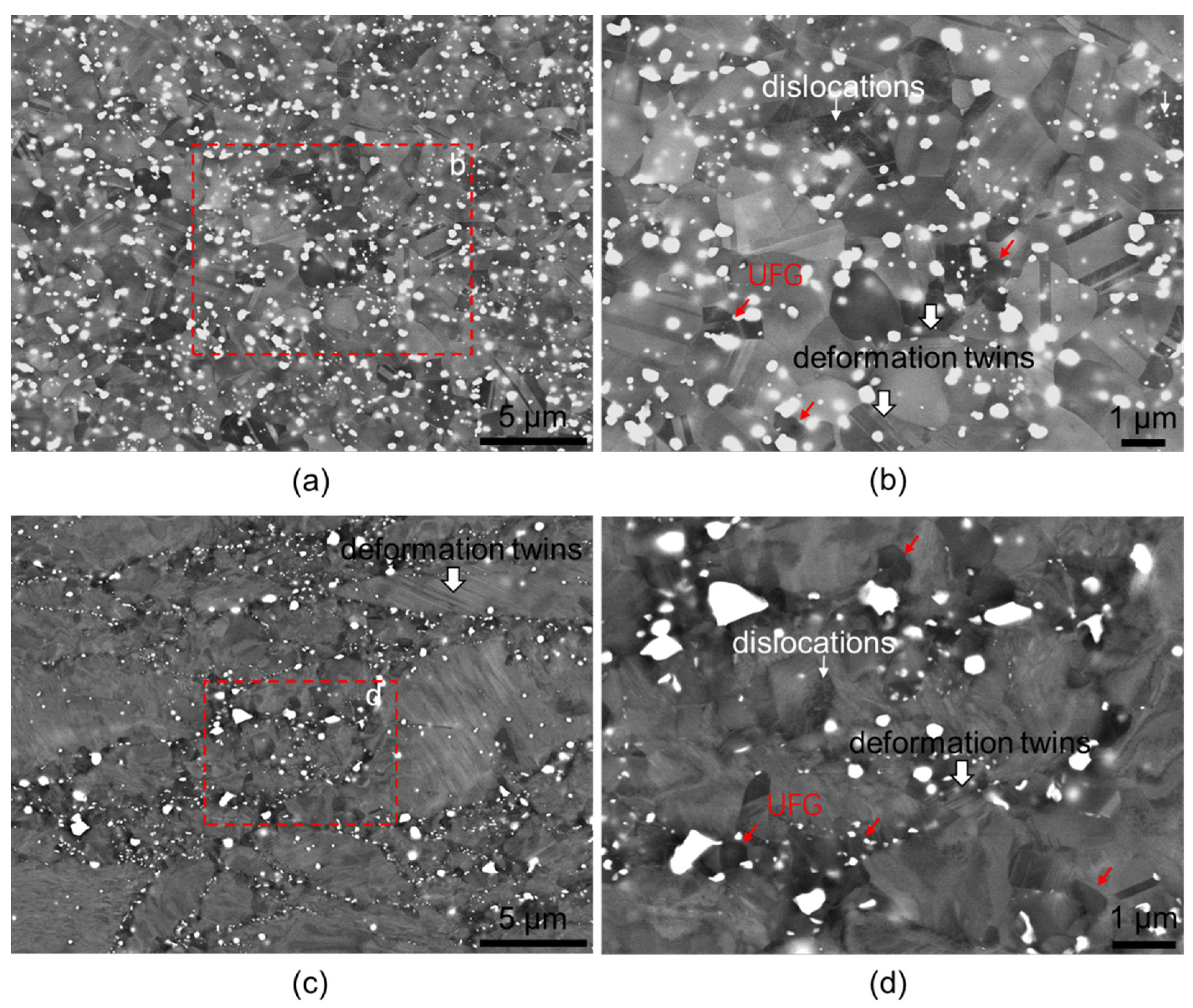High-Temperature Tensile Properties of a Cobalt-Based Co-20Cr-15W-10Ni Superalloy with a Bimodal Grain Structure
Abstract
:1. Introduction
2. Materials and Methods
3. Results
3.1. Initial Microstructures
3.2. High-Temperature Tensile Properties
3.3. Grain Structure Evolution during High-Temperature Deformation
3.4. Substructure Evolution during High-Temperature Deformation
4. Discussion
5. Conclusions
Author Contributions
Funding
Data Availability Statement
Acknowledgments
Conflicts of Interest
References
- Sato, J. Cobalt-Base High-Temperature Alloys. Science 2006, 312, 90–91. [Google Scholar] [CrossRef] [PubMed]
- Coutsouradis, D.; Davin, A.; Lamberigts, M. Cobalt-based superalloys for applications in gas turbines. Mater. Sci. Eng. 1987, 88, 11–19. [Google Scholar] [CrossRef]
- Gui, W.; Zhang, H.; Yang, M.; Jin, T.; Sun, X.; Zheng, Q. The investigation of carbides evolution in a cobalt-base superalloy at elevated temperature. J. Alloy. Compd. 2017, 695, 1271–1278. [Google Scholar] [CrossRef]
- Klarstrom, D.L. Wrought cobalt- base superalloys. J. Mater. Eng. Perform. 1993, 2, 523–530. [Google Scholar] [CrossRef]
- Sims, C.T. A contemporary view of cobalt-base alloys. JOM 1969, 21, 27–42. [Google Scholar] [CrossRef]
- Knezevic, M.; Carpenter, J.S.; Lovato, M.L.; Mccabe, R.J. Deformation behavior of the cobalt-based superalloy Haynes 25: Experimental characterization and crystal plasticity modeling. Acta Mater. 2014, 63, 162–168. [Google Scholar] [CrossRef]
- Favre, J.; Fabrègue, D.; Maire, E.; Chiba, A. Grain growth and static recrystallization kinetics in Co- 20Cr-15W-10Ni ( L-605 ) cobalt-base superalloy. Philos. Mag. 2014, 94, 1992–2008. [Google Scholar] [CrossRef]
- Zhu, Z.; Chen, L. Effect of annealing on microstructure and mechanical properties of biomedical hot-rolled Co-Cr-W-Ni alloy. Mater. Res. Express 2019, 6, 126511. [Google Scholar] [CrossRef]
- Teague, J.; Cerreta, E.; Stout, M. Tensile properties and microstructure of haynes 25 alloy after aging at elevated temperatures for extended times. Metall. Mater. Trans. A 2004, 35, 2767–2781. [Google Scholar] [CrossRef]
- Keyvani, M.; Garcin, T.; Fabrègue, D.; Militzer, M.; Yamanaka, K.; Chiba, A. Continuous Measurements of Recrystallization and Grain Growth in Cobalt Super Alloys. Metall. Mater. Trans. A 2017, 48, 2363–2374. [Google Scholar] [CrossRef]
- Yanagihara, S.; Ueki, K.; Ueda, K.; Nakai, M.; Nakano, T.; Narushima, T. Development of Low-Yield Stress Co–Cr–W–Ni Alloy by Adding 6 Mass Pct Mn for Balloon-Expandable Stents. Metall. Mater. Trans. A Phys. Metall. Mater. Sci. 2021, 52, 4137–4145. [Google Scholar] [CrossRef]
- Ueki, K.; Yanagihara, S.; Ueda, K.; Nakai, M.; Nakano, T.; Narushima, T. Overcoming the strength-ductility trade-off by the combination of static recrystallization and low-temperature heat-treatment in Co-Cr-W-Ni alloy for stent application. Mater. Sci. Eng. A 2019, 766, 138400. [Google Scholar] [CrossRef]
- Narushima, T.; Mineta, S.; Kurihara, Y. Precipitates in Biomedical Co-Cr Alloys. JOM 2013, 65, 489–504. [Google Scholar] [CrossRef]
- Ueki, K.; Ueda, K.; Narushima, T. Precipitate phases and mechanical properties of heat- Treated ASTM F 90 Co-Cr-W-Ni alloy. Key Eng. Mater. 2014, 616, 258–262. [Google Scholar] [CrossRef]
- Sun, F.; Mantovani, D.; Prima, F. Carbides and their Role in Advanced Mechanical Properties of L605 Alloy: Implications for Medical Devices. Mater. Sci. Forum 2014, 783–786, 1354–1359. [Google Scholar] [CrossRef]
- Ueki, K.; Ueda, K.; Nakai, M.; Nakano, T.; Narushima, T. Microstructural changes during plastic deformation and corrosion properties of biomedical Co-20Cr-15W-10Ni alloy heat-treated at 873 K. Metall. Mater. Trans. A 2018, 49, 2393–2404. [Google Scholar] [CrossRef]
- Zhu, Z.-Y.; Meng, L.; Chen, L. Strain-induced martensitic transformation in biomedical Co–Cr–W–Ni alloys. Rare Met. 2020, 39, 241–249. [Google Scholar] [CrossRef]
- Onuki, Y.; Sato, S.; Nakagawa, M.; Yamanaka, K.; Mori, M.; Hoshikawa, A.; Ishigaki, T.; Chiba, A. Strain-Induced Martensitic Transformation and Texture Evolution in Cold-Rolled Co–Cr Alloys. Quantum Beam Sci. 2018, 2, 11. [Google Scholar] [CrossRef] [Green Version]
- Favre, J.; Koizumi, Y.; Chiba, A.; Fabregue, D.; Maire, E. Deformation Behavior and Dynamic Recrystallization of Biomedical Co-Cr-W-Ni (L-605) Alloy. Metall. Mater. Trans. A 2013, 44, 2819–2830. [Google Scholar] [CrossRef]
- Favre, J.; Fabrègue, D.; Yamanaka, K.; Chiba, A. Modeling dynamic recrystallization of L-605 cobalt superalloy. Mater. Sci. Eng. A 2016, 653, 84–92. [Google Scholar] [CrossRef]
- Kumar, V.A.; Gupta, R.K.; Murty, S.V.S.N.; Durga, A. Hot workability and microstructure control in Co20Cr15W10Ni cobalt- based superalloy. J. Alloy. Compd. 2016, 676, 527–541. [Google Scholar] [CrossRef]
- Gupta, R.K.; Karthikeyan, M.K.; Bhalia, D.N.; Ghosh, B.R.; Sinha, P.P. Effect of microstructure on mechanical properties of refractory Co-Cr-W-Ni alloy. Met. Sci. Heat Treat. 2008, 50, 175–179. [Google Scholar] [CrossRef]
- Samii Zafarghandi, M.; Abbasi, S.M.; Momeni, A. Effects of Nb on hot tensile deformation behavior of cast Haynes 25 Co-Cr-W-Ni alloy. J. Alloy. Compd. 2019, 774, 18–29. [Google Scholar] [CrossRef]
- Chiba, A.; Li, X.G.; Kim, M.S. High work-hardening rate and deformation twinning of Co-Ni-based superalloy at elevated temperatures. Philos. Mag. A 1999, 79, 1533–1554. [Google Scholar] [CrossRef]
- Li, C.-L.L.; Park, C.H.; Choi, S.-W.W.; Lee, S.-W.W.; Hong, J.-K.K.; Yeom, J.-T.T. High strength and high ductility in the Co–20Cr–15W–10Ni alloy having a bimodal grain structure achieved by static recrystallization. Mater. Sci. Eng. A 2018, 732, 70–77. [Google Scholar] [CrossRef]
- Li, C.-L.; Oh, J.M.; Yeom, J.-T.; Park, C.H. Bimodal grain-structure formation in a Co–Cr-based superalloy during ultrahigh-homologous-temperature annealing without severe plastic deformation. J. Alloy. Compd. 2019, 783, 173–178. [Google Scholar] [CrossRef]
- Li, C.-L.; Oh, J.M.; Choi, S.-W.; Hong, J.-K.; Yeom, J.-T.; Mei, X.-M.; Mei, Q.; Yu, Z.; Park, C.H. Study on microstructure and mechanical property of a biomedical Co-20Cr-15W-10Ni alloy during multi-pass thermomechanical processing. Mater. Sci. Eng. A 2020, 785, 139388. [Google Scholar] [CrossRef]
- Li, C.-L.; Choi, S.-W.; Oh, J.M.; Hong, J.-K.; Yeom, J.-T.; Kang, J.-H.; Mei, Q.-S.; Park, C.H. Bimodal grain structures and tensile properties of a biomedical Co–20Cr–15W–10Ni alloy with different pre-strains. Rare Met. 2021, 40, 20–30. [Google Scholar] [CrossRef]
- Li, C.-L.; Oh, J.M.; Choi, S.-W.; Mei, X.-M.; Hong, J.-K.; Yeom, J.-T.; Mei, Q.-S.; Yu, Z.-T.; Park, C.H. Thermal stability of bimodal grain structure in a cobalt-based superalloy subjected to high-temperature exposure. Rare Met. 2021, 40, 877–884. [Google Scholar] [CrossRef]
- Huang, W.-Q.; Yang, X.-G.; Li, S.-L. Evaluation of service-induced microstructural damage for directionally solidified turbine blade of aircraft engine. Rare Met. 2019, 38, 157–164. [Google Scholar] [CrossRef]
- Qi, H.-Y.; Yang, J.-S.; Yang, X.-G.; Li, S.-L. Low-cycle fatigue behavior of a directionally solidified Ni-based superalloy subjected to gas hot corrosion pre-exposure. Rare Met. 2019, 38, 227–232. [Google Scholar] [CrossRef]
- Wang, H.; Yu, Z.; Zhang, L.; Liu, C.; Zha, M.; Wang, C.; Jiang, Q. Achieving high strength and high ductility in magnesium alloy using hard-plate rolling (HPR) process. Sci. Rep. 2015, 5, 17100. [Google Scholar] [CrossRef] [PubMed] [Green Version]
- Chen, F.; Mei, Q.S.; Li, J.Y.; Li, C.L.; Wan, L.; Zhang, G.D.; Mei, X.M.; Chen, Z.H.; Xu, T.; Wang, Y.C. Fabrication of graphene/copper nanocomposites via in-situ delamination of graphite in copper by accumulative roll-compositing. Compos. Part B Eng. 2021, 216, 108850. [Google Scholar] [CrossRef]
- Raabe, D. Recovery and Recrystallization: Phenomena, Physics, Models, Simulation. In Physical Metallurgy; Elsevier: Amsterdam, The Netherlands, 2014; Volume 1, pp. 2291–2397. [Google Scholar]






Disclaimer/Publisher’s Note: The statements, opinions and data contained in all publications are solely those of the individual author(s) and contributor(s) and not of MDPI and/or the editor(s). MDPI and/or the editor(s) disclaim responsibility for any injury to people or property resulting from any ideas, methods, instructions or products referred to in the content. |
© 2023 by the authors. Licensee MDPI, Basel, Switzerland. This article is an open access article distributed under the terms and conditions of the Creative Commons Attribution (CC BY) license (https://creativecommons.org/licenses/by/4.0/).
Share and Cite
Lei, Y.; Li, C.; Wan, L. High-Temperature Tensile Properties of a Cobalt-Based Co-20Cr-15W-10Ni Superalloy with a Bimodal Grain Structure. Crystals 2023, 13, 232. https://doi.org/10.3390/cryst13020232
Lei Y, Li C, Wan L. High-Temperature Tensile Properties of a Cobalt-Based Co-20Cr-15W-10Ni Superalloy with a Bimodal Grain Structure. Crystals. 2023; 13(2):232. https://doi.org/10.3390/cryst13020232
Chicago/Turabian StyleLei, Yan, Chenglin Li, and Liang Wan. 2023. "High-Temperature Tensile Properties of a Cobalt-Based Co-20Cr-15W-10Ni Superalloy with a Bimodal Grain Structure" Crystals 13, no. 2: 232. https://doi.org/10.3390/cryst13020232



